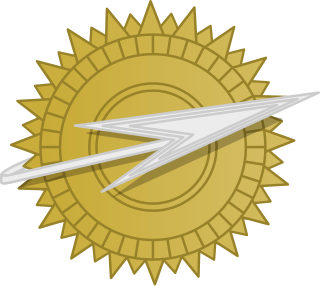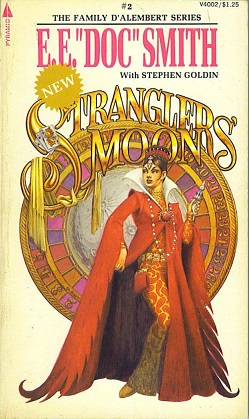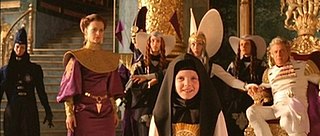Plot summary
In the year 2447 the Empire of Earth comprises more than a thousand inhabited systems. A threat to the Empire has developed that the Imperial secret service SOTE (the Service Of The Empire) has been unable to foil. In desperation they turn to the Family D'Alembert.
The D'Alemberts are natives of the high gravity planet DesPlaines, giving them unusual strength, speed and coordination. They put this to good use by operating the "Circus of the Galaxy," a spectacular combination circus/mobile amusement park famous in every inhabited system, entertaining millions and rarely visiting the same planet twice in an average lifetime.
But the circus is also SOTE's best kept secret, known only to the Head, their designated successor, and the Emperor. Managed by the reigning Duke, who is absolute ruler of DesPlains and head of the D'Alembert family, the circus is a proving ground for the best agents available and can provide a cadre of highly skilled professionals in many fields, as needed. Furthermore, security is absolute, because it is run completely by family members who talk only to each other - and the Head.
So when the Circus is summoned to Earth it is time for Jules and Yvette D'Alembert, brother and sister Imperial Stars, to leave their place in the spotlight under the big top to their successors, and become what they were always meant to be: the Empire's top secret agents.

The word emperor can mean the male absolute ruler of an empire. Empress, the female equivalent, may indicate an emperor's wife, mother/grandmother, or a woman who rules in her own right and name. Emperors are generally recognized to be of the highest monarchic honor and rank, surpassing kings. In Europe, the title of Emperor has been used since the Middle Ages, considered in those times equal or almost equal in dignity to that of Pope due to the latter's position as visible head of the Church and spiritual leader of the Catholic part of Western Europe. The emperor of Japan is the only currently reigning monarch whose title is translated into English as "Emperor".
A monarch is a head of state for life or until abdication, and therefore the head of state of a monarchy. A monarch may exercise the highest authority and power in the state, or others may wield that power on behalf of the monarch. Usually a monarch either personally inherits the lawful right to exercise the state's sovereign rights or is selected by an established process from a family or cohort eligible to provide the nation's monarch. Alternatively, an individual may proclaim themself monarch, which may be backed and legitimated through acclamation, right of conquest or a combination of means.

The Holy Roman Emperor, originally and officially the Emperor of the Romans during the Middle Ages, and also known as the Roman-German Emperor since the early modern period, was the ruler and head of state of the Holy Roman Empire. The title was held in conjunction with the title of king of Italy from the 8th to the 16th century, and, almost without interruption, with the title of king of Germany throughout the 12th to 18th centuries.
A prince is a male ruler or a male member of a monarch's or former monarch's family. Prince is also a title of nobility, often hereditary, in some European states. The female equivalent is a princess. The English word derives, via the French word prince, from the Latin noun prīnceps, from primus (first) and caput (head), meaning "the first, foremost, the chief, most distinguished, noble ruler, prince".

The Galactic Empire is a fictional autocracy featured in the Star Wars franchise. It was first introduced in the 1977 film Star Wars and appears in its two sequels: The Empire Strikes Back (1980) and Return of the Jedi (1983). It is the main antagonistic faction of the original trilogy. An oppressive, autocratic regime with a complicated bureaucracy, the Galactic Empire seeks to ensure singular rule and social control over every planet and civilization within the galaxy.
Galactic empires are a common trope used in science fantasy and science fiction, particularly in works known as 'space operas'. Many authors have either used a galaxy-spanning empire as background or written about the growth and/or decline of such an empire. The capital of a galactic empire is frequently a core world, such as a planet relatively close to a galaxy's supermassive black hole, which has advanced considerably in science and technology compared to current human civilization. Characterizations can vary wildly from malevolent forces attacking sympathetic victims to apathetic bureaucracies to more reasonable entities focused on social progress and anywhere in between.

An imperial cult is a form of state religion in which an emperor or a dynasty of emperors are worshipped as demigods or deities. "Cult" here is used to mean "worship", not in the modern pejorative sense. The cult may be one of personality in the case of a newly arisen Euhemerus figure, or one of national identity or supranational identity in the case of a multi-ethnic state. A divine king is a monarch who is held in a special religious significance by his subjects, and serves as both head of state and a deity or head religious figure. This system of government combines theocracy with an absolute monarchy.
Fürst is a German word for a ruler as well as a princely title. Fürsten were, starting in the Middle Ages, members of the highest nobility who ruled over states of the Holy Roman Empire and later its former territories, below the ruling Kaiser (emperor) or König (king).

King of the Romans was the title used by the king of Germany following his election by the princes from the reign of Henry II (1002–1024) onward.

The Galactic Empire is an interstellar empire featured in Isaac Asimov's Robot, Galactic Empire, and Foundation series. The Empire is spread across the Milky Way galaxy and consists of almost 25 million planets settled exclusively by humans. For over 12 millennia the seat of imperial authority was located on the ecumenopolis of Trantor, whose population exceeded 40 billion, until it was sacked in the year 12,328. The official symbol of the empire is the Spaceship-and-Sun. Cleon II was the last Emperor to hold significant authority. The fall of the empire, modelled on the fall of the Roman Empire, is the subject of many of Asimov's novels.

Archduke was the title borne from 1358 by the Habsburg rulers of the Archduchy of Austria, and later by all senior members of that dynasty. It denotes a rank within the former Holy Roman Empire (962–1806), which was below that of Emperor, and roughly equal to King, Prince-Archbishop, Grand prince and Grand Duke, but above that of a Sovereign Prince and Duke.

Traditional rank amongst European royalty, peers, and nobility is rooted in Late Antiquity and the Middle Ages. Although they vary over time and among geographic regions, the following is a reasonably comprehensive list that provides information on both general ranks and specific differences. Distinction should be made between reigning families and the nobility – the latter being a social class subject to and created by the former.

National Lampoon's Doon is a parody of Frank Herbert's 1965 science fiction novel Dune, written by Ellis Weiner and published in 1984 by Pocket Books for National Lampoon. It was reprinted by Grafton Books (ISBN 0-586-06636-5) in 1985. In 1988 William F. Touponce called the book "something of a tribute to Herbert's success on college campuses", noting that "the only other book to have been so honored is Tolkien's The Lord of the Rings," which was parodied by The Harvard Lampoon in 1969.

The German Emperor was the official title of the head of state and hereditary ruler of the German Empire. A specifically chosen term, it was introduced with the 1 January 1871 constitution and lasted until the official abdication of Wilhelm II on 9 November 1918. The Holy Roman Emperor is sometimes also called "German Emperor" when the historical context is clear, as derived from the Holy Roman Empire's official name of "Holy Roman Empire of the German Nation" from 1512.
Stephen Charles Goldin is an American science fiction and fantasy author.

The Duchy of Austria was a medieval principality of the Holy Roman Empire, established in 1156 by the Privilegium Minus, when the Margraviate of Austria (Ostarrîchi) was detached from Bavaria and elevated to a duchy in its own right. After the ruling dukes of the House of Babenberg became extinct in male line, there was as much as three decades of rivalry on inheritance and rulership, until the German king Rudolf I took over the dominion as the first monarch of the Habsburg dynasty in 1276. Thereafter, Austria became the patrimony and ancestral homeland of the dynasty and the nucleus of the Habsburg monarchy. In 1453, the archducal title of the Austrian rulers, invented by Duke Rudolf IV in the forged Privilegium Maius of 1359, was officially acknowledged by the Habsburg emperor Frederick III.

Line of Delirium and Emperors of Illusions are two 1995 books of a space opera trilogy by Russian science fiction writer Sergey Lukyanenko. The story is told in third person, usually from the viewpoint of Kay Dutch — a professional bodyguard living in a post-war galaxy. The names of races, planets, and several leaders are borrowed from the computer game Master of Orion, although everything else in the trilogy is original, even the physical descriptions of several races.
The Family D'Alembert series is a set of science fiction novels by E. E. 'Doc' Smith. WITH Stephen Goldin, the first of which was expanded from the 1964 novella The Imperial Stars by E. E. "Doc" Smith. The series later served as the basis for Goldin's series Agents of ISIS.

Stranglers' Moon is a 1976 science fiction novel by American writer Stephen Goldin, the second book in the Family D'Alembert series, the first of which was expanded by Goldin from a novella by E.E. “Doc” Smith.

Multiple organizations of the Dune universe dominate the political, religious, and social arena of the setting of Frank Herbert's Dune series of science fiction novels, and derivative works. Set tens of thousands of years in the future, the saga chronicles a civilization which has banned computers but has also developed advanced technology and mental and physical abilities through physical training, eugenics and the use of the drug melange. Specialized groups of individuals have aligned themselves in organizations focusing on specific abilities, technology and goals. Herbert's concepts of human evolution and technology have been analyzed and deconstructed in at least one book, The Science of Dune (2008). His originating 1965 novel Dune is popularly considered one of the greatest science fiction novels of all time, and is frequently cited as the best-selling science fiction novel in history. Dune and its five sequels by Herbert explore the complex and multilayered interactions of politics, religion, ecology and technology, among other themes.
We've a three-point civilization: the Imperial Household balanced against the Federated Great Houses of the Landsraad, and between them, the Guild with its damnable monopoly on interstellar transport.













